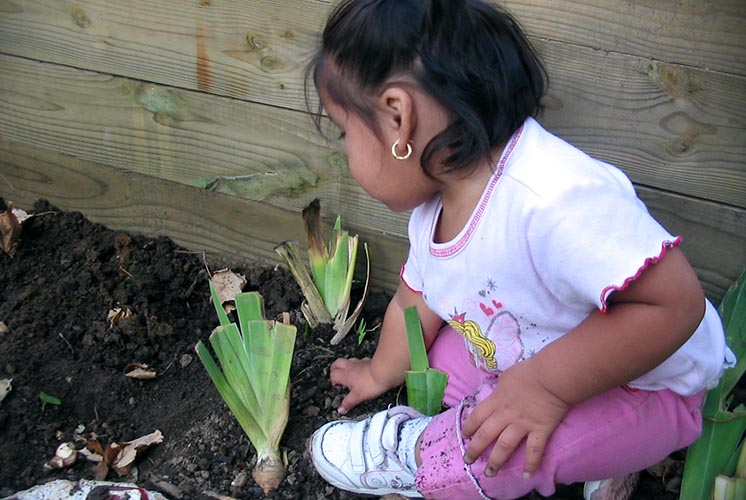 Introduction
Introduction
Research shows that children who play outdoors regularly are happier, healthier, and stronger. Health benefits include stronger immune systems, decreased risk of developing chronic diseases as they grow, improved sleeping patterns, and access to vitamin D.
Outdoor experiences also:
- Strengthen children’s development and learning in all areas of the Head Start Early Learning Outcomes Framework
- Build children’s connection to nature
- Extend curriculum and “present a new world of sights, sounds, smells, and tactile experiences” (Thigpen 2007, 19) that are not available indoors
Program leaders can strengthen infants’ and toddlers’ connections to the outdoors. They do this by working collaboratively with staff and families to fully embrace and support outdoor play and exploration in all program options in urban, suburban, and rural communities.
Strategies
Here are some strategies to consider:
Collect extra snowsuits, raincoats, and other clothes for children that can increase the amount of time spent outside. If applicable, plan for what to do when families you serve do not accept donated clothes.
- Inventory the outdoor experiences that currently exist for infants and toddlers in your program:
- Review your research-based curriculum for information and guidance on outdoor play environments and learning experiences
- Use curriculum fidelity tools to determine the extent to which outdoor play environments are age- and developmentally appropriate, children have access to daily outdoor time, and children have age-, developmentally, and culturally appropriate play and exploration opportunities
- Capitalize on factors that promote these experiences, such as the weather, family interest, staff enthusiasm, the program's outdoor space or access to other outdoor spaces
- Identify factors that might discourage outdoor experiences, such as the weather, safety issues, staff or family discomfort, lack of staff development on the importance of daily outdoor play, and lack of access to safe outdoor spaces. Plan to work with staff, families, and the community to overcome these barriers. For example:
- Encourage staff and families to talk about the value of outdoor time as well as the requirements for the youngest children. Staff, Policy Council members, parent committees, Health Services Advisory Committee members, and individual families have a role in identifying health and safety issues, planning outdoor spaces, and planning for rich developmental experiences outdoors
- Provide staff development on benefits of outdoor play and preparing for and implementing outdoor experiences, including adapting the environment and experiences for children with physical, cognitive, and sensory disabilities
- Talk with families about the value of spending time outside with young children. For example:
- Ask what they think their children might be interested in doing outdoors
- Work with each family to plan experiences that will most interest their child
- Consider any cultural concerns around outside play (e.g., going outside in certain weather conditions, getting dirty or sandy) and work with families to address them
- Identify how your program ensures a safe, healthy, accessible, and developmentally appropriate outdoor environment. For example:
- Daily outdoor safety checks with checklists or other assessments like Head Start Body Start Infant and Toddler Outdoor Play Space Assessment
- Active supervision
- Clearly defined outdoor play spaces, which make planning and supervising outdoor time easier
- Weather-related policies that define when it is safe or not safe to take children outside
- Determine which of your community partners might be interested in supporting outdoor experiences and establish collaborative partnerships
References
Thigpen, Betsy. "Outdoor Play: Combating Sedentary Lifestyles." Zero to Three 28, No. 1 (2007): 19–23.
Head Start Program Performance Standards
- Center-based option, 45 CFR §1302.21:
- (d) Licensing and square footage requirements
- Teaching and the learning environment, 45 CFR §1302.31:
- (c) Learning environment
- (d) Materials and space for learning
- (e) Promoting learning through approaches to rest, meals, routines, and physical activity
- Education in home-based programs, 45 CFR §1302.35:
- (c) Home visit experiences
- (e) Group socialization
- Safety practices, 45 CFR §1302.47:
- (b)(1) Facilities
- (b)(2) Equipment and materials
- (b)(5)(iii) Appropriate indoor and outdoor supervision of children at all times
Resources
Caring for Our Children (CFOC)
- Chapter 6. Play Areas/Playgrounds and Transportation
- Caring for Infants and Toddlers in Early Care and Education (I/T)
Nature-Based Learning and Development
News You Can Use
- Environment as Curriculum for Infants and Toddlers
- Outdoor Spaces
- Bringing the Outdoors into Infant and Toddler Environments
Outdoor Play Benefits
Supporting Outdoor Play and Exploration for Infants and Toddlers, Technical Assistance Paper No. 14
« Go to Head Start Tip Sheets for Grantee Planning
Read more:
Resource Type: Article
National Centers: Early Childhood Development, Teaching and Learning
Last Updated: March 20, 2025
